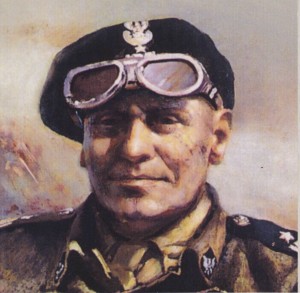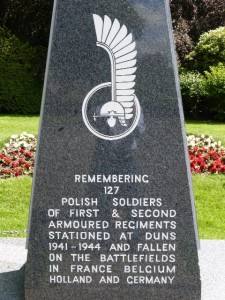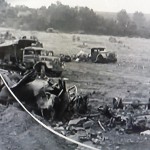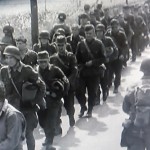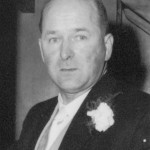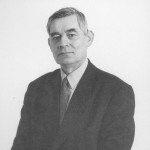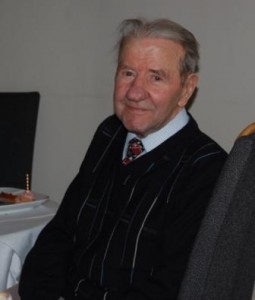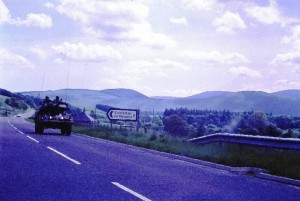The Polish Connection
The building and grounds of Barony Castle were requisitioned for use by the Polish Army during the Second World War. At the time of the Armistice between France and Germany in June 1940, Polish troops were already being evacuated to Britain as allies in the fight against Nazi Germany. Around 17,000* Polish soldiers were directed to Scotland where they were housed temporarily in camps around Crawford, Douglas and Biggar (later also Peebles) before establishing more permanent bases north of the Forth in Fife, Angus and Perthshire. (*This number represented about a quarter of the Polish troops who had been in France and was gradually augmented by later arrivals released from Russian captivity and recruited from the Polish diaspora, some being recruited from as far away as South America. By May 1944 the figure had increased to approximately 26,500.) Regrouped as the 1st Polish Corps under their Commander-in-Chief General Władysław Sikorski, the Poles were entrusted in October 1940 with the defence of a long stretch of the east coast of Scotland against a possible German invasion. While the main enemy landings were expected to take place in southern England, the War Office feared the possibility of a diversionary attack on Britain from German-occupied Norway. The Poles took over existing coastal defences and strengthened them by creating anti-tank barriers and pill boxes in their sector between Arbroath (later extended to Montrose, 38 miles north of Dundee) and Burntisland on the north shore of the Firth of Forth. In the Spring of 1942 they gave up responsibility for Angus, taking over instead the defences of East Lothian. Three armoured trains, out of a total of 12 for the whole of Britain, were based from July 1940 in Scotland, in Aberdeen, Stirling and Edinburgh [Longniddry]. From November 1940 the Polish Army took over the running of all the armoured trains, starting with those in Scotland. “[In defence plans] the whereabouts of Polish troops, due to the need to preserve secrecy, was designated by the general title ‘somewhere in Scotland’…” — 2nd Lieutenant Zbigniew Mieczkowski In 1942 some of the Polish front-line units were reorganised as the 1st Polish Armoured Division under the esteemed tank commander General Stanisław Maczek. In the same year Barony Castle became the main Polish staff officer training college (the Polish Higher Military School having suspended activities on the fall of Warsaw in 1939). It is known that General Maczek attended the closing ceremony of one of the staff courses in Eddleston in March or April 1943.
Having played a notable part in the 1939 campaign in southern Poland and fought in France, Maczek, now based at Forfar, was charged with bringing the 1st Polish Armoured Division to battle readiness in time for the Normandy landings of 1944. (Its fighting strength was 15,000 men, 300 tanks and 1600 artillery pieces.) As part of its preparations the Division was moved to the Borders from April 1942 for intensive training. Polish troops became a regular sight in Galashiels, Kelso, Earlston, Lauder, Greenlaw, Duns and Kelso.
During the Normandy campaign the Division played a crucial role in closing the ‘pocket’ formed at the battle of the Falaise Gap. The Poles helped successfully bottle up most of the German VII Army and V Panzer Division as part of a pincer movement executed by the Canadian and American armies; the Poles, in General Montgomery’s words, forming the “cork” of the bottle. Cut off from the other Allied armies, for three days they successfully resisted repeated attempts by the Germans to break out of the pocket, while at the same time repulsing the II SS-Panzer Division attempting to break in to free the trapped forces. The overall strategy proved successful. The Germans suffered major losses of manpower and material, and an estimated 40-50,000 German prisoners were taken – but at the cost of heavy casualties amongst the Poles. Some 2,300 were wounded or killed in the engagement. Maczek’s Division moved on to liberate the Dutch town of Breda in October 1944 and took the surrender of the German naval base of Wilhelmshaven in May 1945. By the end of the campaign the Division had lost a third of its strength.
* * * * *
(You can see photographs of the 1st Armoured Division’s progress in Europe via this link — note that the end quotation should state “other nations”, not “all nations”.) (This documentary shows the fighting in the Falaise Gap (from approx. 46:18 mins to 1hr 10 mins). The Polish contributor is Zbigniew Mieczkowski, whose tribute to General Maczek can be found on our Educational Resources page. Warning: contains graphic footage of war casualties.)
- Abandoned German vehicles at Falaise
- Captured German soldiers
Field Marshal Bernard Montgomery’s Message To Troops 17.9.1944
* * * * *
After the war Maczek, like most of his soldiers, had no wish to live in a Communist Poland controlled by the Soviet Union where the personal safety of Poles who had fought in the West was far from guaranteed. He made Scotland his home, and died in Edinburgh in 1994 at the age of 102. In the early 1960s, Tomasik and Maczek became neighbours and good friends in Edinburgh. In the 1970s, as private guests of Tomasik, the retired general and his family enjoyed summer holidays at the Hotel Black Barony when ‘The Great Polish Map of Scotland’ was being constructed by a team of Poles led by Dr. Kazimierz Trafas. Maczek’s tank commander’s interest in topography and contours, as demonstrated at the Falaise Gap, has led to speculation that he may have had some input into the construction of the map, his presence in the background leading to his name becoming popularly associated with it. The military tradition of planning strategies on scale-modelled landscapes suggests that The Great Polish Map of Scotland may be an echo of that tradition.
- Jan Tomasik (d.1991)
- Kazimierz Trafas (d.2004)
Like Maczek, many Polish ex-servicemen stayed in Scotland after the war. Many married Scottish women and started families whose descendants combine the Scottish and Polish cultures within their families and societies. Since Poland became a member of the European Union in 2004 they have been joined by a new generation of Poles which in 2009 was estimated to number about 70,000.
Our thanks go to Robert Ostrycharz for his advice and support in preparing this article.
* * * * *
You can read more about the map here And more about Scottish-Polish links on our Did You Know? page
* * * * *
A Scottish-Polish encounter in 1940
A Polish soldier recalls his first lesson in integration in Glasgow (from T. Devine and D Hesse (eds.) Scotland and Poland, John Donald 2011).
When we came out [of church] we were surrounded by people. Of course the problem was they couldn’t understand us like we could understand them but there was one family with two young schoolgirls. One spoke German, one spoke French. We gathered enough words to more or less converse and they took us to their home, a beautiful home. Such a luxury we didn’t see for months and months. The table was quite laden – the lunch ready with salad and salmon sandwiches and the glitter of the china and cutlery. It took us quite a while to remember the table etiquette after being in the wilds. The girls were such a good help to us. They were asking us questions about where we came from and who we were and where is Poland? We had to tell them the story how we came from Poland through Hungary and now we are in England and they said no, no, not England, this is Scotland.
***********
A Survivor
Zenon Sliwinski is one of the last living Second World War veterans in Scotland who served in the 1st Armoured Division under General Maczek. Mr Sliwinski lives in his adopted home of Glasgow. During the war he was based in Duns in the Scottish Borders and fought in the Normandy campaign.
His life before joining the 1st Armoured Division was one of exile and travel: a common experience of Polish soldiers who found themselves stationed in Scotland during the war.
He was living on his family’s farm in Eastern Poland, when the country was divided between Nazi Germany and the Soviet Union in 1939. He still recalls a severe winter’s day when he, his mother and two younger brothers were given two hours by the Soviets to pack a few belongings before being marched to a station to be crammed in to a railway cattle wagon with other Polish exiles. There was a small stove in the middle of the three-tiered wagon and a hole in the floor for the toilet. They travelled in this wagon for well over a week. Mr Sliwinski remembers that one night his head froze to a bunk. On arrival in the Archangel area they were transferred to sledges on which they travelled for another six days. The corpses of those who died on this journey were left by the side in the snow.
When Germany invaded Russia in 1941, the Poles became officially, though reluctantly, allies of the Russians and consequently Mr Sliwinski and his family were released from captivity. They travelled south by train and worked on a collective farm in the south Volga area.
From here, Mr Sliwinski travelled to Tehran and in the Spring of 1942 joined the Polish army. His mother and youngest brother were transferred to a peanut plantation in Kenya and his other brother went to Palestine. Given Mr Sliwinski’s knowledge of tractors and mechanics he was assigned to the 1st Armoured Division as a tank driver. The Scottish Borders area offered wide open spaces and terrain suitable for tank training during the war. Mr Sliwinski remembers testing a tank that could operate underwater.
The 1st Armoured Division fought with great gallantry in Normandy in 1944 and during a particularly savage encounter with the enemy Mr Sliwinski was badly wounded. He was treated for his wounds in the field before being transferred to a military hospital in Liverpool.
At the war’s end, Mr Sliwinski decided to stay in the Britain and make Scotland his home. His other three family members returned to a Poland that was now a Communist totalitarian state.
He started visiting Poland in the 1970s but was initially treated with suspicion by Polish officials. With the demise of the Communist regime, travel became much easier. He now returns to his native country every year to visit his daughter who lives and works in Krakow.
To this day, he remains disappointed that political decisions at the time resulted in Polish combatants not participating in the London official victory parade of 1946; nor were they given the recognition they deserved after the war. The restoration of Mapa Scotland is one small act of gratitude and respect to the brave Poles, like Zenon Sliwinski, who fought alongside our nation during the Second World War.
